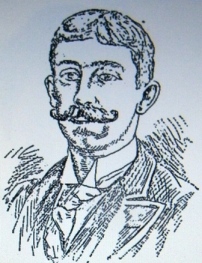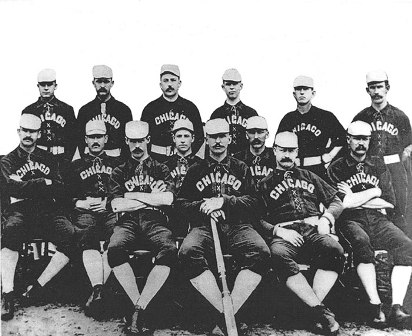Thomas Timothy “Tim” Flood just couldn’t control himself.
Flood was a solid infielder and somewhat erratic hitter. As a 17-year-old he hit .364 with the New Orleans Pelicans in the Southern Association in 1894 but hit .266 in his minor league career and .233 as a Major Leaguer.
He had a late season 10-game trial with his hometown St. Louis Perfectos in the National League in 1899. He was given his next shot in the National league in 1902 when he was signed by Ned Hanlon’s Brooklyn Superbas to fill the void left at second when veteran Tom Daly jumped his contract to join the Chicago White Sox.
Flood was an upgrade in the field, and while a weaker hitter than Daly, he quickly became a favorite of Hanlon who named him Brooklyn’s captain for the 1903 season.
1903 was not a good season for the new captain; he continued to struggle at the plate and dealt with a knee injury that limited him to 84 games. He was also suspended for two games in July for a physical altercation in Cincinnati with umpire James “Bug” Holiday. Holiday, a former Major Leaguer had a stormy half season as a National league umpire and resigned several days after tangling with Flood.
Flood was released by Brooklyn in March of 1904 and joined the Los Angeles Angels in the Pacific Coast League.
He was a very popular player in Los Angeles and captained the Angeles in 1904 and part of 1905 until he assaulted Ira “Slats” Davis, another former Major Leaguer turned umpire during a game in June of 1905. Eugene Bart, president of the league suspended flood indefinitely.
Newspapers reported that Flood said he would “never fight another arbitrator whether he is in the right or wrong.”
In 1906, he signed with the Altoona Mountaineers in the “outlaw” Tri-State League, where he appears to have kept his pledge and had an incident-free season.
In 1907, he joined the Toronto Maple Leafs in the Eastern League and managed to play 29 games before he was in trouble again. Flood assaulted an umpire named John Conway during a game in Toronto; the attack included a kick to the umpire’s chest.
Flood was arrested.
He was charged with assault and ordered to appear in front of a magistrate. Friends told Flood the hearing would be a formality and that he should plead guilty and receive a small fine.
No one told Magistrate George Taylor Denison who said, “This sort of thing must be discouraged,” and sentenced Flood to “Fifteen days in jail with hard labor.” At the same time Patrick Powers, president of the Eastern League, banished Flood from the league.
Toronto fans were outraged and immediately began circulating petitions which “included the names of several clergymen” and were presented by team officials to Minister of Justice Allen Bristol Aylesworth in hopes of getting Flood pardoned.
Opinions of the punishment varied. Several newspapers carried the following poem which lamented Flood’s fate for “Sassing” an umpire:
“’Holy Moses!’ In Toronto
There is news to make you pale
Sass the umpire if you want to—
That is, want to go to jail!
There is woe among the batters,
As around the field they scud;
And their pride is torn to tatters
By the fate of poor Tim Flood
Fifteen days in jail for Timmy
Soon the parks will close so tight
That you couldn’t with a jimmy
Let in one small streak of light.”
Others, including two former players, said Flood got what he deserved and implied that his behavior was not limited to the three well-publicized incidents.
Charles “Count” Campau, a former Major Leaguer and umpire, who had been a teammate of Flood’s in New Orleans said:
“I am sorry to see anyone go to jail, but, for the good of baseball. I am glad to see Tim Flood out of it for good. Rowdies of the Flood type are a disgrace to any sport or business, and especially baseball. He was always mixed up in just this way and was chased out of California, where b« was playing, for the same kind of tricks. Umpire baiting was always his long suit, and, from what I can understand, his attack on Umpire Owens [sic] was a most cowardly one: Flood is a good ballplayer, but his hasty temper, his meanness has put him out of the game forever, and incidentally Into Jail.”
Tim Murnane, Major Leaguer turned baseball writer said:
“Tim Flood has a new record, and will now be in a position to go back to his trade and give up the game he was unfitted for. The courts all over the country should follow the example of the Canadian judge, who sent a ballplayer to lock-up for assaulting an umpire. It wouldn’t take many decisions of this kind to drive the bad men out of the sport. Imagine a player taking a running jump at a man and hitting him in the breast with his spiked shoes!”
After serving 10 days, Minister of Justice Aylesworth ordered Flood released. The player, in various reports, claimed he lost between 10 and 16 pounds during his incarceration, citing the poor quality of the food.
President Powers rejected pleas from the Toronto management to reinstate Flood and permanently banned him from the Eastern League; however, contrary to Campau’s and Murnane’s wishes, Flood was out of baseball for less than a month.
Flood was signed before the end of July by the Saint Paul Saints in the American Association and vowed, as he had before, that he was a changed man.
It appears 10 days in jail might have made a difference. Flood was named manager of the Saints in 1908 and continued to play and manage in the minor leagues for five more seasons, apparently without incident.
In 1914, The Sporting Life reported, with no irony, that Flood was hired as an umpire in the Northern League.
Flood died in St’ Louis in 1929.





6 Responses to “Anger Management”